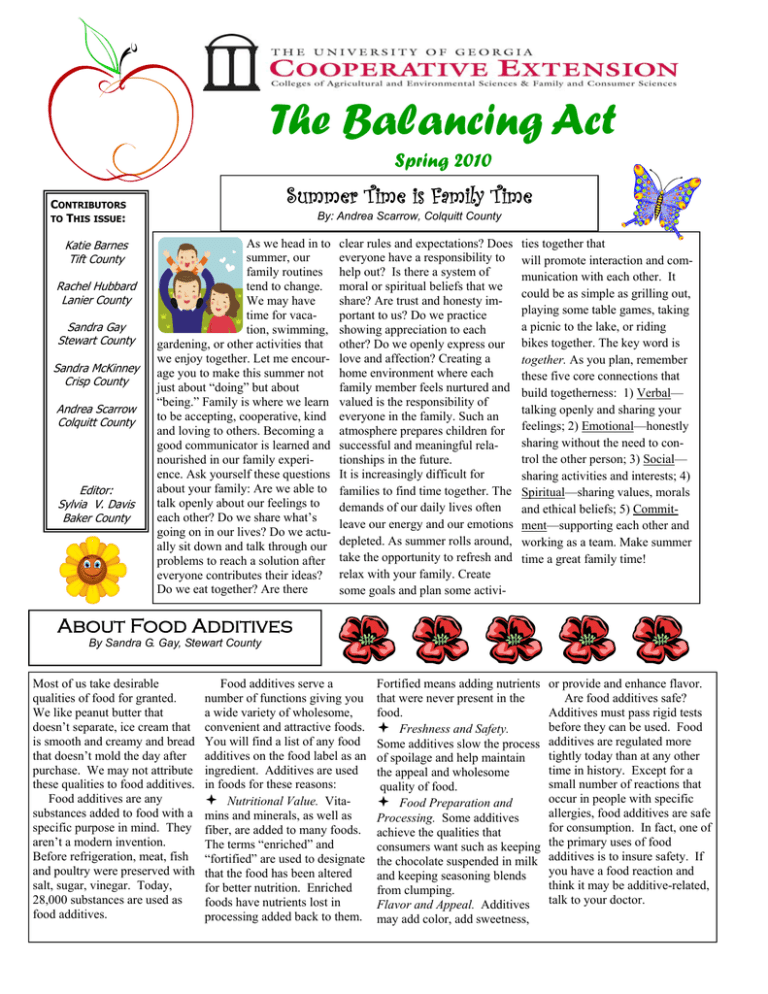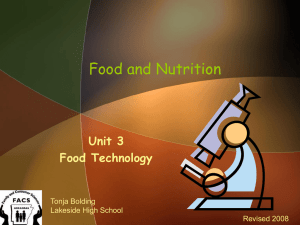The Balancing Act Spring 2010
advertisement

The Balancing Act Spring 2010 Summer Time is Family Time CONTRIBUTORS TO THIS ISSUE: Katie Barnes Tift County Rachel Hubbard Lanier County Sandra Gay Stewart County Sandra McKinney Crisp County Andrea Scarrow Colquitt County Editor: Sylvia V. Davis Baker County By: Andrea Scarrow, Colquitt County As we head in to summer, our family routines tend to change. We may have time for vacation, swimming, gardening, or other activities that we enjoy together. Let me encourage you to make this summer not just about “doing” but about “being.” Family is where we learn to be accepting, cooperative, kind and loving to others. Becoming a good communicator is learned and nourished in our family experience. Ask yourself these questions about your family: Are we able to talk openly about our feelings to each other? Do we share what’s going on in our lives? Do we actually sit down and talk through our problems to reach a solution after everyone contributes their ideas? Do we eat together? Are there clear rules and expectations? Does everyone have a responsibility to help out? Is there a system of moral or spiritual beliefs that we share? Are trust and honesty important to us? Do we practice showing appreciation to each other? Do we openly express our love and affection? Creating a home environment where each family member feels nurtured and valued is the responsibility of everyone in the family. Such an atmosphere prepares children for successful and meaningful relationships in the future. It is increasingly difficult for families to find time together. The demands of our daily lives often leave our energy and our emotions depleted. As summer rolls around, take the opportunity to refresh and relax with your family. Create some goals and plan some activi- ties together that will promote interaction and communication with each other. It could be as simple as grilling out, playing some table games, taking a picnic to the lake, or riding bikes together. The key word is together. As you plan, remember these five core connections that build togetherness: 1) Verbal— talking openly and sharing your feelings; 2) Emotional—honestly sharing without the need to control the other person; 3) Social— sharing activities and interests; 4) Spiritual—sharing values, morals and ethical beliefs; 5) Commitment—supporting each other and working as a team. Make summer time a great family time! About Food Additives By Sandra G. Gay, Stewart County Most of us take desirable qualities of food for granted. We like peanut butter that doesn’t separate, ice cream that is smooth and creamy and bread that doesn’t mold the day after purchase. We may not attribute these qualities to food additives. Food additives are any substances added to food with a specific purpose in mind. They aren’t a modern invention. Before refrigeration, meat, fish and poultry were preserved with salt, sugar, vinegar. Today, 28,000 substances are used as food additives. Food additives serve a number of functions giving you a wide variety of wholesome, convenient and attractive foods. You will find a list of any food additives on the food label as an ingredient. Additives are used in foods for these reasons: Nutritional Value. Vitamins and minerals, as well as fiber, are added to many foods. The terms “enriched” and “fortified” are used to designate that the food has been altered for better nutrition. Enriched foods have nutrients lost in processing added back to them. Fortified means adding nutrients that were never present in the food. Freshness and Safety. Some additives slow the process of spoilage and help maintain the appeal and wholesome quality of food. Food Preparation and Processing. Some additives achieve the qualities that consumers want such as keeping the chocolate suspended in milk and keeping seasoning blends from clumping. Flavor and Appeal. Additives may add color, add sweetness, or provide and enhance flavor. Are food additives safe? Additives must pass rigid tests before they can be used. Food additives are regulated more tightly today than at any other time in history. Except for a small number of reactions that occur in people with specific allergies, food additives are safe for consumption. In fact, one of the primary uses of food additives is to insure safety. If you have a food reaction and think it may be additive-related, talk to your doctor. Smart Shopping at the Grocery Store By Rachel Hubbard, Lanier County Out of all of the spending categories in your budget, you can exercise the most control over groceries because you make the decision on buying every item. Here are some tips for saving money at the grocery store. Never go into the grocery store without a list. If you do, you are much more likely to buy things you do not need. Shop without a list and you are more likely to forget something, resulting in another trip to the grocery and more impulse buys. Get to know the store you use the most, and list the items you need in order of where they are in the store. Buy fresh fruit and vegetables when they are in season. You will get a fresher product and hang on to more of your money. Your food section in your local newspaper usually features articles and recipes on seasonal items. Use coupons to save money on items you usually buy anyway. Conversely, do not buy items just because you have a coupon if you would not normally buy them. Make sure that what is shown to be on sale is really a bargain for you. Do not stick to name brands. Consider buying the store brand instead of the national brand. If you compare ingredients, you will often find no difference between brands. Store brands are often as good or even better in some instances than national brands. Use the unit price to compare costs. The unit price is how much the item costs per ounce, pound or other unit. The largest size of an item is not always the cheapest. You can find the unit price on the shelf sticker. Paying attention to how you shop at the grocery store can help you to get more for your food dollar. Saving a few dollars each trip to the store may seem to be more trouble than it is worth. Those few dollars each week can add up to a lot of money in a year or two. LEAVE CONTAMINANTS AT THE DOOR By: Sandra McKinney, Crisp County Where did you walk today before you arrived at your home? Did you walk in a public restroom, down the street, through mud or dirt and through the grass? The first four steps you take inside your back door bring in close to 85% of the outdoor contaminants found inside your home. The bottom of your shoes could have pesticides, dirt, dust, lead dust, pollen, dust mites, animal dander, hair, cigarette ashes, fungal spores and more. These contaminants can affect the cleanliness of your home and also impact the health of children, anyone with asthma or respiratory problems, or people with a weakened immune system. It’s simple to leave it at the door using a doormat system and removing your shoes inside the door. Leaving contaminants at the door has time, economic, and health benefits. You save money by reducing wear and tear on your carpets and floors. You save time when less cleaning is required. The health benefits come from reducing your exposure to pesticides, lead dust, and asthma and allergy triggers. Place a grate-like scraper mat outside your entry door and scrape your feet on it before going inside. Just inside the door, place a highly absorbent doormat that will trap soil and water below shoe level. If you have space, add a second doormat as a finishing mat. The purpose of this second indoor mat is to capture and hold any remaining particles or moisture on the bottom of your shoes. A good doormat has a non-slip backing and it is made with a reinforced surface to avoid wearing out quickly. Keep your doormats clean so they can do their job well. You may even want to consider removing your shoes as you enter your home to further reduce the contaminants in your home environment. Picnic Safety By: Katie Barnes, Tift County It’s that time of year for picnics and fun in the sun! Many of you may be considering a picnic lunch at a special location such as your favorite beach. Picnic baskets will be full of goodies and summer treats! Packing your own lunch can help to save money and often be much healthier, however picnic baskets left out too long during travel or in the heat can quickly become a foodborne illness threat. Here are a few tips on packing a safe picnic meal. Prepare picnic meals that do not require refrigeration. Peanut butter and jelly is one of the best foods to pack or any other foods that don’t require refrigeration. When using mayonnaise (i.e. potato salad) and lunch meats, they could fall into the “danger zone” which is between 41 degrees – 135 degrees. That is where bacteria grows best! Perishable foods such as meat, poultry, eggs and dairy products should not be left at room temperature for more than two hours. If the temperature exceeds 90 degrees then they should not be left out longer than 1 hour. Prepackage dry foods such as whole grain chips or crackers are also good snacks to choose. Foods that sit outside a refrigerated area until lunchtime are in the temperature danger zone far too long which means bacteria can grow until you or your family is ready to eat. Therefore, packing an insulated cooler with cool packs will help to ensure that a safe temperature for foods is maintained during travel and activity. The best thing to do is to include cold packs in your insulated cooler or picnic container. Preparing sandwiches and freezing them and the drink could also help in keeping your food a safe temperature for longer periods of time. Soups, chilies, and stews for lunch need to be kept in an insulate container such as a thermos. Before putting hot soup, chili or stew in the container, fill the container with boiling water and let it stand for a few minutes. Do not open the container before lunchtime so that heat is not lost. Remember to keep hot foods hot and cold foods cold! When purchasing a cooler or picnic food container, it is important to consider size, good insulation and ease of cleaning. Purchase a hard or soft-sided, well-insulated container or cooler. Make sure it is well made, easy to pack, and does not limit food choices. Check to see that it has room for a chill packs, thermos (if taking hot foods), beverages and food for the entire family. Using food grade containers with lids is a perfect way to transport food and keep it safe from outside contaminates. It should also be water resistant or have a water-proof lining with no exposed seams to trap dirt. Making sure that your food is safe can help your summer shine! Clip and Save Banana Strawberry Smoothie 1 cup milk 1 carton strawberry yogurt 2 tablespoon powder sugar 4 fresh strawberries (sliced) 1 banana (sliced) 2 cups ice (optional) Put all ingredients in blender and smooth. Enjoy The University of Georgia and Fort Valley State University, the U.S. Department of Agriculture and counties of state cooperating. The Cooperative Extension offers educational programs, assistance and materials to all people without regard to race, color, national origin, age, sex or disability. An equal opportunity/affirmative action organization committed to a diverse work force. COLLEGE OF AGRICULTURAL AND ENVIRONMENTAL SCIENCES, COLLEGE OF FAMILY AND CONSUMER SCIENCES WARNELL SCHOOL OF FOREST RESOURCES, COLLEGE OF VETERINARY SCIENCES LEARNING FOR A LIFETIME The Balancing Act: Your Current Issue Enclosed Place Stamp Here The University of Georgia Cooperative Extension The University of Georgia Cooperative Extension College of Agriculture and Environmental Sciences/Athens, Georgia 30602-4356 Dear Friends, The Balancing Act is a quarterly publication sent to you by Family and Consumer Sciences Agents serving all Southwest Georgia. All information in this newsletter is written by Specialists at the University of Georgia and FACS agents, and is backed by research from the University of Georgia and the U.S. Department of Agriculture. This newsletter brings you the latest information, please contact the agent in your county. Thank you, Katie Barns Peggy Bledsoe Roxie Booker Wayne Coachman Sylvia Davis Sandra Gay Rachel Hubbard Joan Mason Sandra McKinney Polly Morgan Andrea Scarrow Suzanne Williams Tift County Houston County Brooks County Early County Baker County Stewart County Lanier County Sumter County Crisp County Seminole County Colquitt County Dougherty County (229) 391-7980 (478) 987-2028 (229) 263-4103 (229)723-3072 (229) 734-3015 (229) 838-4908 (229) 482-3895 (229) 924-4476 (229) 276-2612 (229) 524-2086 (229) 616-7455 (229) 436-7216


